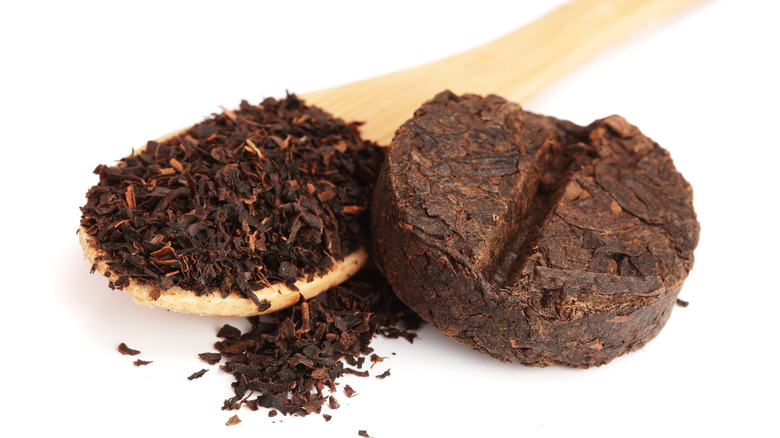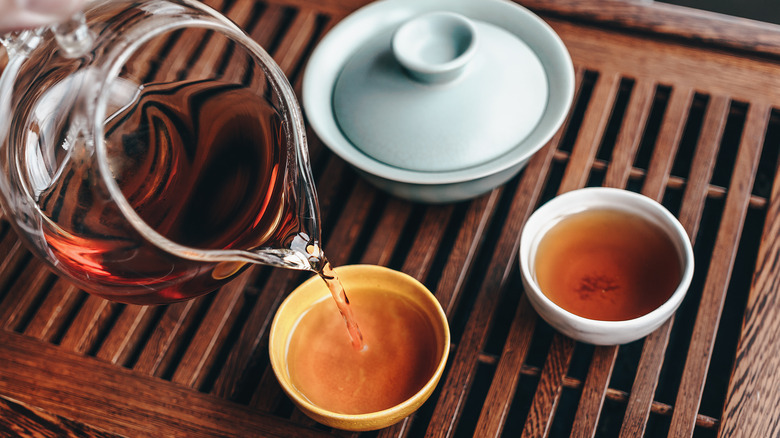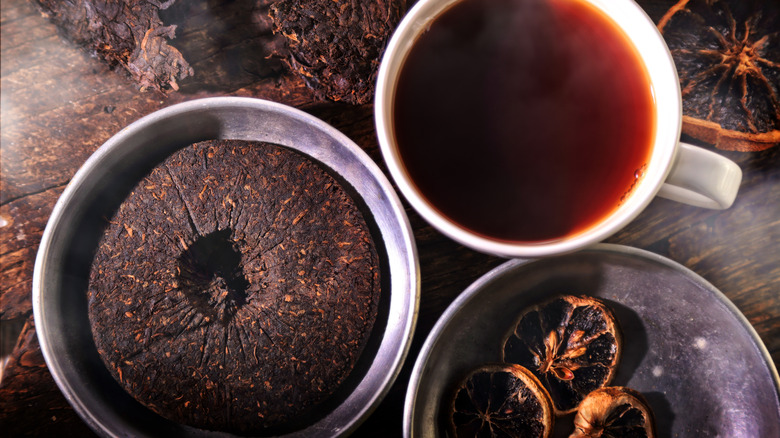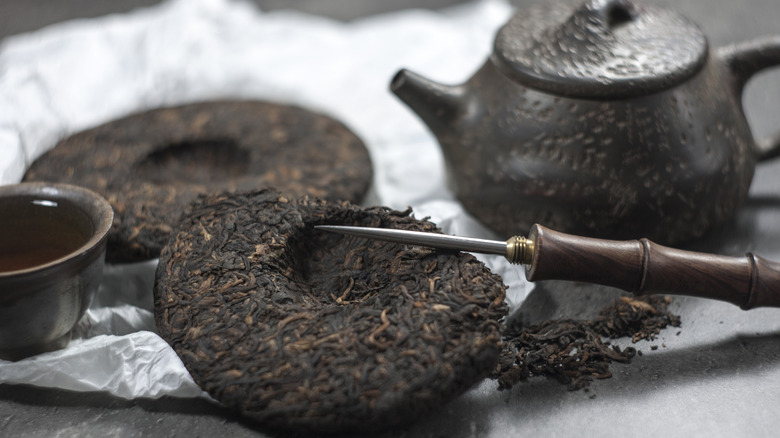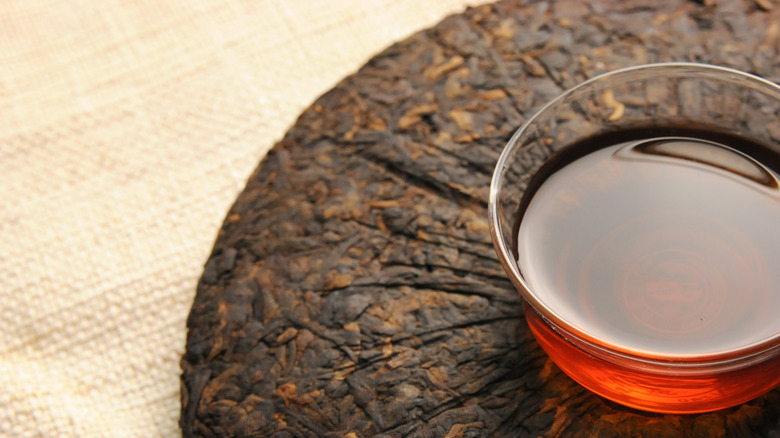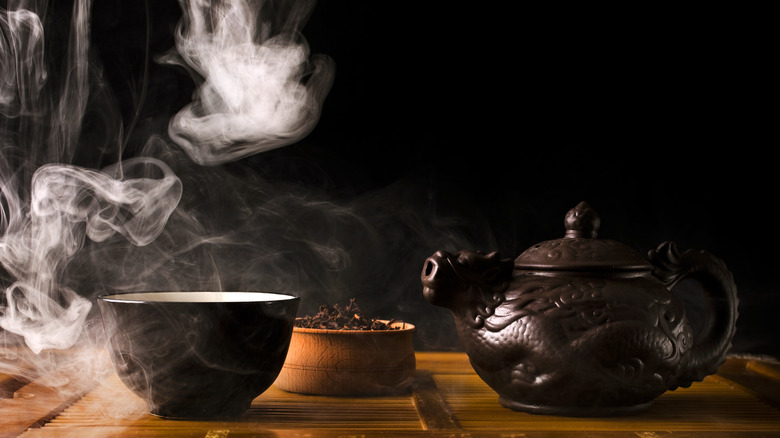What Is Pu-Erh Tea And What Does It Taste Like?
If you enjoy a cup of tea every now and then, you probably stick mainly to green, black, and herbal varieties — the more popular blends that occupy the shelves of grocery stores and markets. If you drink tea often, you may dabble in oolong, rooibos, or white teas.
Pu-erh tea, however, is in an entirely new league. This semi-rare tea is grown in the Yunnan Province of China (per The Spruce Eats) and has reputed health benefits. The taste of pu-erh tea varies depending on how it's aged and for how long, and even those flavors can differ greatly based on outside factors. Due to the fermentation process pu-erh tea undergoes, it can stay fresh for up to 50 years and ages like a high-quality wine. While it may not be commonplace in the United States yet, this tea appears to be rising in popularity, and it seems there are plenty of good reasons why we should be drinking it more frequently.
What is pu-erh tea?
While all tea is made from similar plants (part of the camellia sinensis family), pu-erh tea comes from one very specific plant. According to Serious Eats, "For a tea to be called pu-erh, it must be made from the large-leaf subspecies camellia sinensis var. assamica and grown in Yunnan Province in China's southwest." The leaves must then be allowed to ferment for a period of time, whether that be weeks, months, years, or even decades.
While oolong and black teas oxidize when exposed to air, pu-erh tea is actually fermented and exposed to bacteria and yeasts. Per NPR, this fermented and aged tea can fetch prices higher per gram than silver if the leaves are correctly harvested, fermented, and aged. According to Simple Loose Leaf, pu-erh tea is one of the oldest tea varieties in the world, with a history that dates back over 1,000 years. It comes in two main types: raw or ripe pu-erh.
Raw pu-erh vs. ripe pu-erh
While the difference between raw pu-erh (sheng pu'er) and ripe pu-erh (shou pu'er) may seem small, there are actually some big differences between the two types of pu-erh tea. The type of aging process employed is what sets the two types of tea apart.
They both undergo the same steps initially: they're harvested, withered, pan-fried or steamed, rolled, sun-dried, and aged. Raw pu-erh is pressed into cakes and aged in a humidity and temperature-controlled environment, where it can be aged for upward of 50 years. Ripe pu-erh undergoes an accelerated aging process; they're piled together, sprayed with water, and left to ferment in a hot and humid environment for two to seven weeks before being pressed into cakes and dried. This method imitates the process used to age raw pu-erh but takes place over a much shorter period. Raw pu-erh has a wider range of flavors that vary with the time it's been aged, whereas ripe pu-erh tea closely mimics aged raw pu-erh but has a narrower range of flavor.
What does pu-erh tea taste like?
There are myriad different flavors you can experience when drinking pu-erh tea, and this is largely due to the time the tea has spent aging, aging conditions, types of fungi and bacteria that develop, the conditions of storage, brewing methods, plus whether it is raw or ripe pu-erh.
According to Simple Loose Leaf, "raw pu-erh is more fresh, more mellow and often more light. It can have woody, smokey, tobacco, floral or spring lawn notes. Raw pu-erh may have some bitterness, followed by a sweet aftertaste." Ripe pu-erh is usually earthy and does not ever have the bitter flavor the young raw pu-erh may have. A few less-than-desired tasting notes that can arise from poor fermentation or aging include a fishy taste, a dirty taste, and a moldy taste. When done correctly, however, pu-erh teas should showcase a variety of pleasant flavors, including tobacco, an earthy flavor with fresh moss, and woody notes.
Benefits of pu-erh tea
It's no secret that tea provides us with tons of benefits: the high levels of antioxidants and detox properties found in many teas make this beverage highly popular and great for you. Pu-erh tea is less researched than its black and green counterparts, but there are still studies that have indicated tons of benefits.
One such study, published by NCBI, found that "consumption of [pu-erh tea extract] was associated with statistically significant weight loss when compared to placebo." This peer-reviewed research article also concluded that pu-erh tea is high in antioxidant properties, making it great for our overall health in many areas. PiqueTea also writes that pu-erh tea may be good for skin, due to "crazy high levels of catechins ... a type of polyphenol that acts as a powerful antioxidant. This boasts natural antibacterial and antimicrobial properties that may keep your pores clear and free of grime." Clear skin, weight loss, and antioxidants? We'll take a whole pot, please.
Where to buy pu-erh tea
Depending on how aged your pu-erh tea is, the cost can be a little steep (ha, ha, get it?). On top of that, it's difficult to know if you're getting genuine and quality pu-erh tea or not, so be sure to do a little research beforehand. Serious Eats has a list of five trusted vendors that all offer different types of pu-erh tea, which is a great place to start if you're interested in trying this unique brew but don't know where to start. Imbibe Magazine also published a list of several places where you can purchase this fermented tea without worrying if you're getting ripped off or not. If you feel like you might be spending too much on tea, keep in mind that pu-erh tea can be steeped up to 10 times, so you're getting a lot of use out of a little bit of tea. Drink up and enjoy!
